
Although stars are inanimate objects, we tend to describe their stages of evolution as if they were alive. Just like us, they are born, live and then die. Of course, their lifetimes are much longer than ours and they can ‘live’ for billions of years. And during their lives, stars produce monumental amounts of energy through nuclear processes in their interior, giving them their characteristic shine. So let’s start at the beginning. Where do stars come from?
Matter is not distributed equally in space. In between the voids of emptiness, there are regions of gas and dust clouds, called the interstellar medium, which are denser than their surroundings. Usually, the kinetic energy of the clouds’ particles will be balanced by the gravitational force of the cloud. However, if the cloud is disturbed, perhaps by a nearby supernova, the balance is broken and the cloud may become denser in certain areas.
When they reach a certain critical mass, the densest parts of the cloud can contract under the influence of their own gravitational attraction, causing the cloud to fragment into smaller and denser sections. This process takes a few million years. As the cloud contracts, the temperature and the density increases. Eventually, the new object and gains a spherical shape and becomes what is called a protostar. Due to its gravitational pull, matter from the cloud still falls into it, continuously raising the temperature and density until they become so large that nuclear reactions start where the hydrogen fusions to make helium. A new star is born.
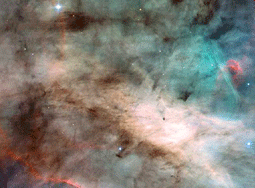
In the center of this gas and dust cloud called Omega nebula continuously new stars are formed. Source: NASA
Most stars are born within the arms of a spiral galaxy, where there is more gas and dust. Sometimes, several stars can form within the same molecular cloud, and we have what is known as a star cluster. There are two types of cluster; open clusters, which tend to contain a few hundred relatively young, hot stars that quite spaced out, and globular clusters, that tend to contain thousands of much older stars, more densely packed together.
Excepting the Sun, most stars are extremely far away. The nearest star, Proxima Centauri, is 4.24 light years away. This means that when astronomers observe stars, it’s difficult to see exactly what’s going on. They mainly observe two things: the luminosity of the star and its colour.
When astronomers speak about the luminosity of a star, what they mean is the absolute magnitude, that is the real brightness of a star and not the apparent brightness that would depend on how far it is from us. This is normally measured on a logarithmic scale with respect to our Sun: for example, if a star has a luminosity of 1, then it has the same brightness as our Sun. The colour of a star is related to its surface temperature: 'hotter' stars appear to be bluer than colder stars, which are reddish.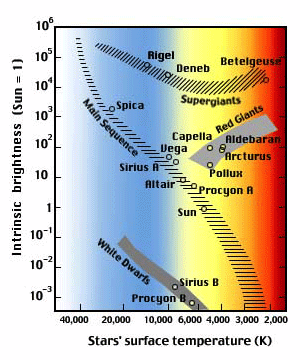
One can create a 2-dimensional plot with the stars' surface temperatures versus their luminosity. The plot could look like the one here on the right.
This is probably the most important diagram in astronomy, the Hertzsprung-Russell diagram, named after the two astronomers that first drew it. On the horizontal axis is the surface temperature increasing from right to left, and on the vertical axis is the energy output or luminosity of the star.Interestingly, the stars on the Hertzsprung-Russell diagram are not distributed evenly. Instead, they form a very distinct pattern. Most of the stars lie on a band from the top left of the diagram (large, bright, hot stars) to the bottom right (small, dim, cool stars). This is called the Main Sequence. At the top right of the diagram are very large, bright but cool stars which we call Red Giants and at the bottom left corner are the White Dwarfs, small, dim, but extremely hot stars.
For roughly 90% of a star's life, the star will be relatively stable and have roughly the same luminosity, surface temperature and size. At this point in its evolution, the star is in hydrostatic equilibrium. Therefore, its position on the Hertzsprung-Russell diagram does not change. In this state, the star is a Main Sequence star: our Sun is a prime example. They range from hot and bright starts at the top left of the Hertzsprung-Russell diagram to cooler and dimmer at bottom right. Stars can stay in this phase for a very long time. However, the timescales for stars are not all the same. Larger stars tend to burn their fuel much faster and, therefore, run out much quicker. Smaller stars don’t need to use as much energy to counterbalance their gravity, hence have longer lives.
The stages of a star's life are defined by how much and what type of fuel the star has. During the Main Sequence, stars use hydrogen as their fuel. When the hydrogen begins to run out, the star produces less energy to support its weight and the core begins to contract. This increases the temperature and density in the core and the luminosity of the star increases as a result. Through the enhanced heat released, the radius of the star increases by 100 to 1000 times its original size but with more of the surface to heat up and less fuel to do it with, the surface temperature can decrease as much as 50%, and the star becomes redder. Such stars are called Red Giants. On the Hertzsprung-Russell diagram, they are located in the right upper corner.
For small stars (that is less than 8 times the mass of the Sun), at the end of the Red Giant phase, the star can’t contract enough to generate the temperatures needed for further nuclear fusion. With no nuclear processes to power it, the outer layers of the star become unstable and the stellar wind produced by the star blows them away. From Earth, we can see this as huge colourful clouds rapidly moving away from the star, leaving just the star core behind. This cloud moving away from the star is called a planetary nebula.
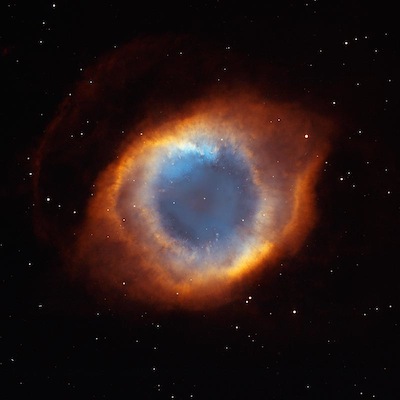
The leftover core is small but very dense and hot. They’re called White Dwarfs after their small size but white-hot surface. They’re so dense that just a tea-spoon of their material would weigh the same as an elephant on Earth. White Dwarfs are located at the lower left corner of the Hertzsprung-Russell diagram. For small stars like our Sun, the leftover core will consist of carbon (and a little oxygen) but for bigger stars, it could be made from neon.
These stars are no longer fusing material together so they will lose their heat with time. Eventually, they’ll dim and become Brown Dwarfs.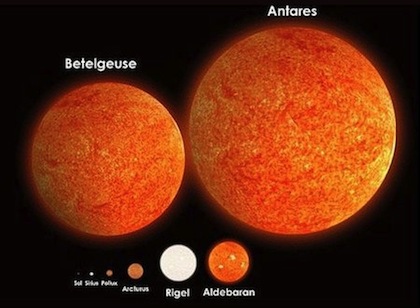
As we’ve seen, there are many different types of stars and they can vary by a lot. The most obvious difference between them is size. The picture below shows a few stars from our galaxy. There are three red giants: Antares, Betelgeuse and Aldebaran. Rigel is a blue supergiant. Sirius is a main-sequence star but bigger than our Sun - shown as a small dot at the bottom leff, tiny in comparison to the others. White Dwarfs are so small that they can’t be shown to scale on this picture. Source: NASA.
For a stars with mass more than 8 times the mass of our Sun, death is signalled by a gigantic explosion: during the first second it can be as bright as a whole galaxy with hundreds of billions of stars. Such explosions are called Type-II Supernovas.
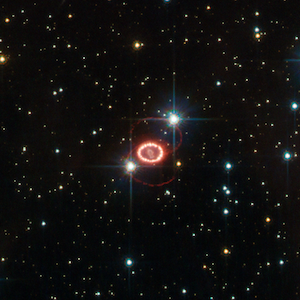
Even though the stellar explosion took place around 166000 BC, it was observed by us on 23 February 1987. SN 1987A was one of the brightest stellar explosions since the invention of the telescope more than 400 years ago. Source: NASA/HUBBLE
During a supernova, all the matter contracts in the core of the exploding star. This means that protons and electrons are compressed together so tightly that they become neutrons. There is a limit to how much neutrons can be compressed and so eventually the core stopd contracting and a Neutron Star is formed.
Neutron Stars consist only of neutrons and have a radii of only about 10 km. However, a Neutron Star it is so dense that just one teaspoon of their material has about 20 times the mass of the Great Pyramid of Giza. In fact, Neutron Stars are the densest objects we know of.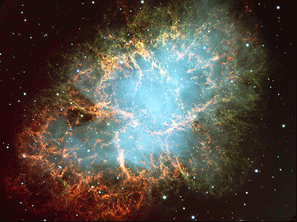
The best known Pulsar is located at the centre of the Crab Nebula. The Crab Nebula is a cloud created in a supernovae explosion observed by Chinese astronomers in 1054 AD. The Crab Nebula is expanding ever since. In the centre of this cloud is a pulsar, that is a Neutron Star rotating about 30 times per second. Source: NASA
To create a Black Hole, the star core must have mass of more 2.5 times that of the Sun. At such high masses, the gravitational force of the core is so high that when the star material rapidly collapses in, the repulsion force between neutrons can’t counteract it. The matter just keeps on falling, creating a denser and denser object, until eventually it becomes a Black Hole.
A Black Hole is a part of space in which so much mass (hence gravitation) is concentrated that nothing - not even light - can escape from it. This is known as a singularity because all the matter is concentrated in one single point. As no light can escape it, black holes appear … black. This means that astronomers can’t see them. However, they can be detected by observing the temperature increase of surrounding matter when it spirals and is swallowed by the Black Hole. These Black Holes usually have masses ranging from about 4 to 10 times the mass of the Sun.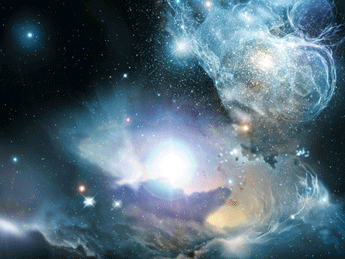
However, there are other types of Black Holes. Astronomers have also discovered Supermassive Black Holes (SBH), which have masses millions of times bigger than our Sun. These have been found at the centre of galaxies. There’s even one in the centre of our own galaxy. It’s called Sagittarius A* and its mass is roughly 4 million times the mass of Sol. Some SBHs create powerful jets called quasars.
Artistic impression of a distant quasar in the early Universe. The surrounding dense gas, dust and even stars produce the brightness of the quasar when sucked into the SBH. Source: NASA
Quasars can emit the energy of hundreds of galaxies from an area that is not much larger than our solar system. Quasars are found only very far away and were formed when the Universe was much younger and the density of the matter surrounding the SBH was much larger. The Black Holes remaining now in the centre of galaxies have already swallowed most of the matter surrounding them and therefore produce much less energy. Surprisingly, the story doesn’t stop there, astronomers have found one more type of Black Hole: the intermediate black hole, with masses hundreds of times bigger than our Sun. This is a fairly recent discovery and astronomers are not completely sure of what to make of it. While the studies seem to prove their existence, no one can explain how they are created as they seem far too big to result from stars!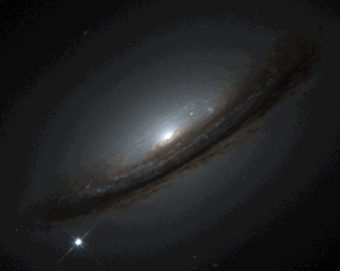
The deposited matter at the surface of the White Dwarfs explodes. Such an explosion is called a nova (in Latin this means "new"), because it looks as if a new star appeared in the sky. About each year about tens of such novae are observed in the Milky Way alone. The star is bright for some days or weeks before it dims again. Recurrent novae were also observed, with repeat intervals of years or decades.
Far away a star exploded as a type-I supernova. It is visible as the bright spot on the lower left, occurred in the outskirts of a galaxy (Image source: NASA). This is the second posibility: the White Dwarf can blow up in a gigantic explosion, called a type-I supernova. These supernovae can happen just as often and can be as bright as type-II supernovae: they can have the brightness of hundreds of billions of stars.

The outcome depends on the mass of the star.